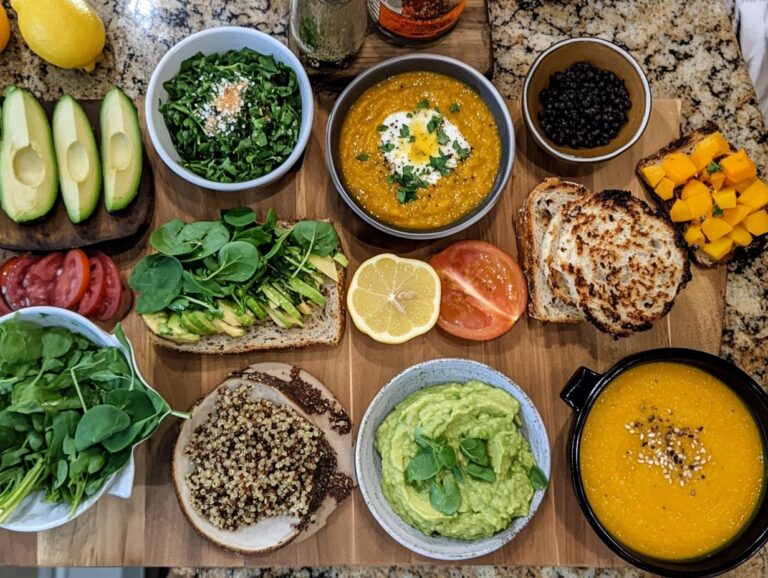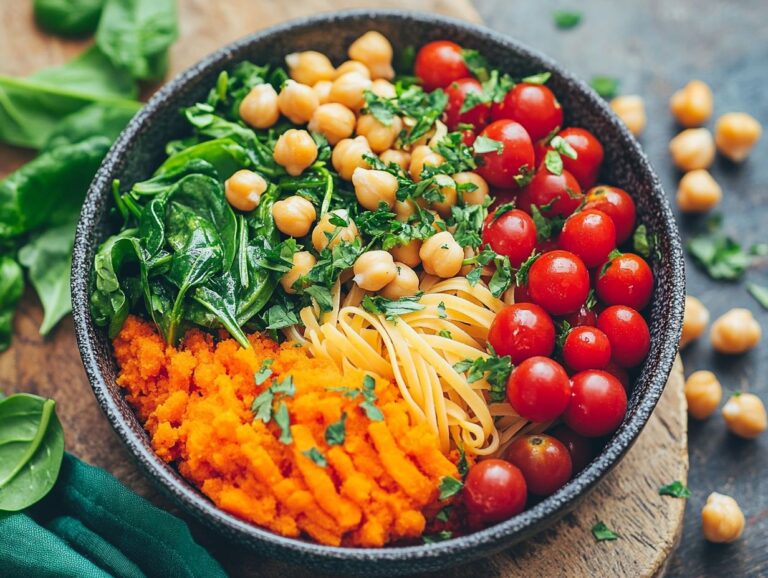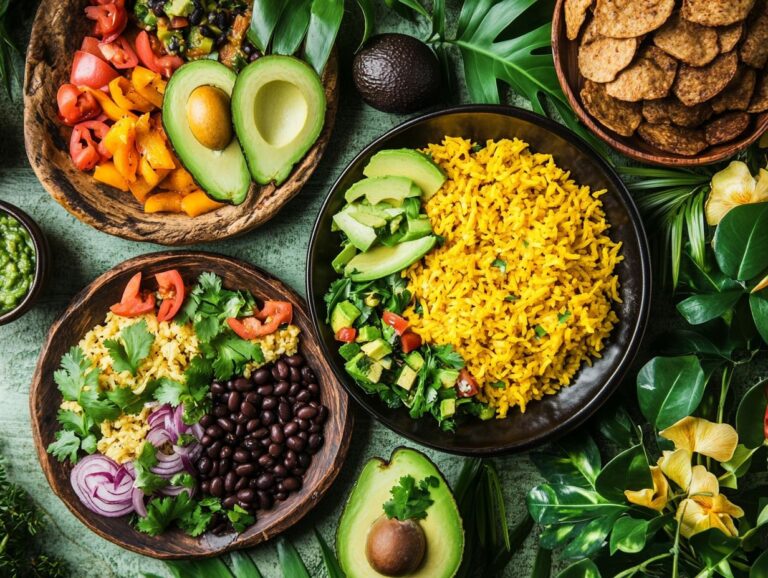Japanese cuisine is renowned worldwide for its incredible flavors and beautiful presentation, making it well-suited for a plant-based lifestyle. Discover how traditional Japanese meals can be transformed into delicious vegan dishes that span breakfast, lunch, dinner, and dessert. Whether you are in search of quick lunch ideas or one-pot dinners for busy evenings, you will find a variety of recipes that highlight the rich flavors of Japanese cooking while adhering to vegan principles. Get ready to demonstrate that vegan eating can be both delicious and diverse!
What Makes Japanese Cuisine Vegan-Friendly?
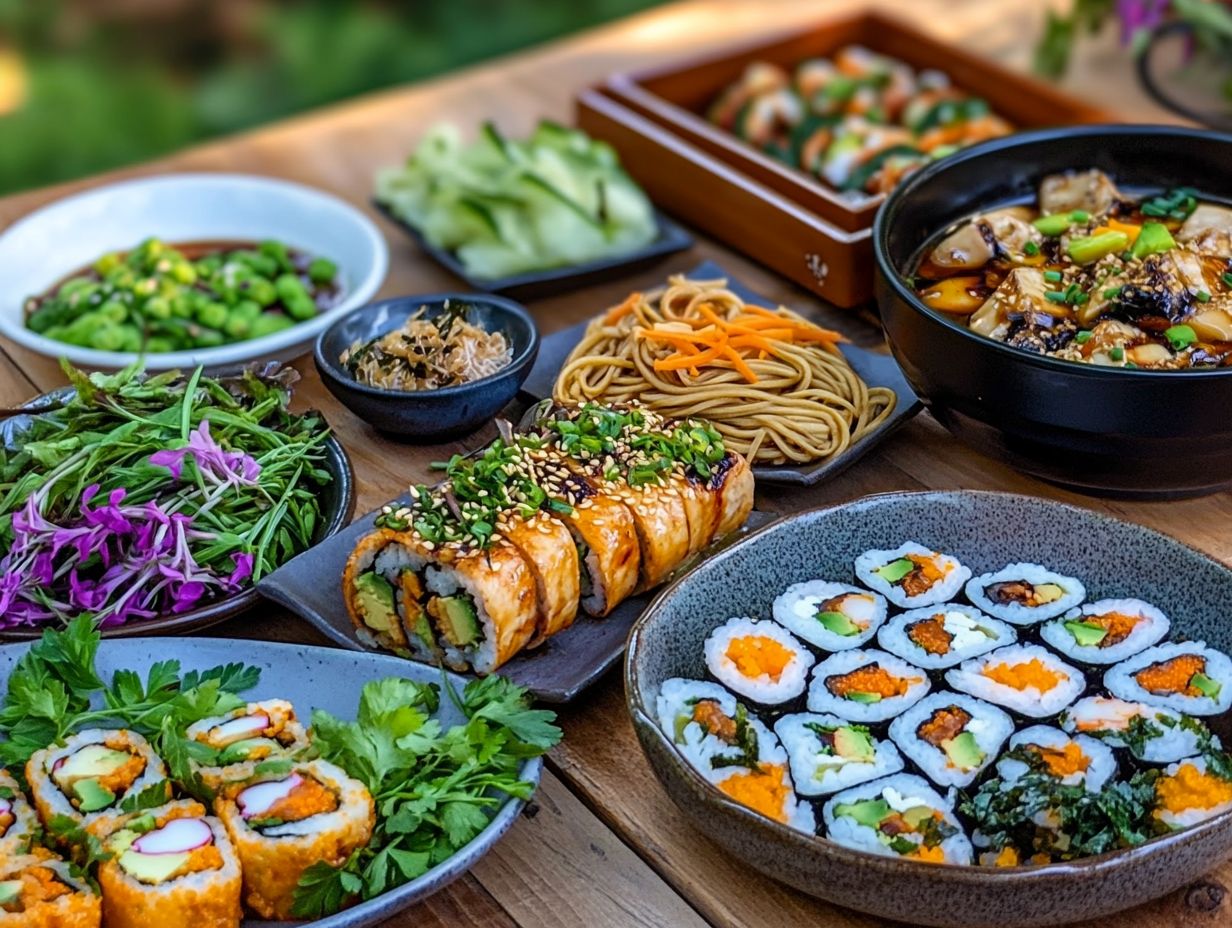 Japanese cuisine boasts a rich and diverse array of flavors and surprisingly offers numerous vegan-friendly versions of traditional dishes that retain the authentic taste and flavor profiles of their non-vegan counterparts. Dishes such as miso soup, sushi rolls, and ramen can easily be made vegan by substituting ingredients like tofu and seaweed for fish and meat, while incorporating fresh vegetables, kombu, and umami-rich elements to enhance the flavors. Furthermore, the cooking techniques commonly used in Japanese cuisine, such as steaming and stir-frying, strongly support plant-based adaptations, ensuring that the final products are both flavorful and enjoyable for all palates. This combination of health emphasis and cultural integrity fosters a culinary environment that encourages the growth of veganism, supported by organizations like the Vegan Japan Society.
Japanese cuisine boasts a rich and diverse array of flavors and surprisingly offers numerous vegan-friendly versions of traditional dishes that retain the authentic taste and flavor profiles of their non-vegan counterparts. Dishes such as miso soup, sushi rolls, and ramen can easily be made vegan by substituting ingredients like tofu and seaweed for fish and meat, while incorporating fresh vegetables, kombu, and umami-rich elements to enhance the flavors. Furthermore, the cooking techniques commonly used in Japanese cuisine, such as steaming and stir-frying, strongly support plant-based adaptations, ensuring that the final products are both flavorful and enjoyable for all palates. This combination of health emphasis and cultural integrity fosters a culinary environment that encourages the growth of veganism, supported by organizations like the Vegan Japan Society.
Breakfast Recipes
Traditional Japanese vegan breakfast recipes offer a simple and nutritious way to start the day, featuring dishes like miso soup and onigiri. Dishes such as miso soup with seasonal vegetables, rice balls (onigiri), and an array of bento box breakfast ideas provide essential nutrients while also delivering comfort and simplicity. For added variety, creative bento box options can include tofu, fresh salads, and more.
Traditional Japanese Breakfast Options
A typical Japanese breakfast consists of several dishes that offer a harmonious blend of flavors and nutritional components, including rice, miso soup, a variety of vegetables, meats, and fish. This combination creates a wholesome and balanced meal. Tofu, a common protein source for vegans, is prepared in various ways in Japanese cuisine, most often grilled, scrambled, or added to soups. Pickled vegetables and miso dressing enhance the meal with flavor and richness. To further elevate a plant-based Japanese breakfast, one can include a bowl of natto, which has a distinct flavor and is rich in probiotics, making it a delicious and healthful addition. Seaweed salads made with wakame or nori are also wonderful choices, providing essential vitamins and minerals. Seasonal vegetables, such as saut ed greens or steamed root vegetables, add delightful variety to the meal. Another way to introduce sweetness to a plant-based Japanese breakfast is by adding a scoop of anko (sweet red bean paste) to rice or spreading it on whole grain toast. This provides a delicious twist while staying true to the essence of a traditional Japanese breakfast.
Vegan Takes on Classic Breakfast Dishes
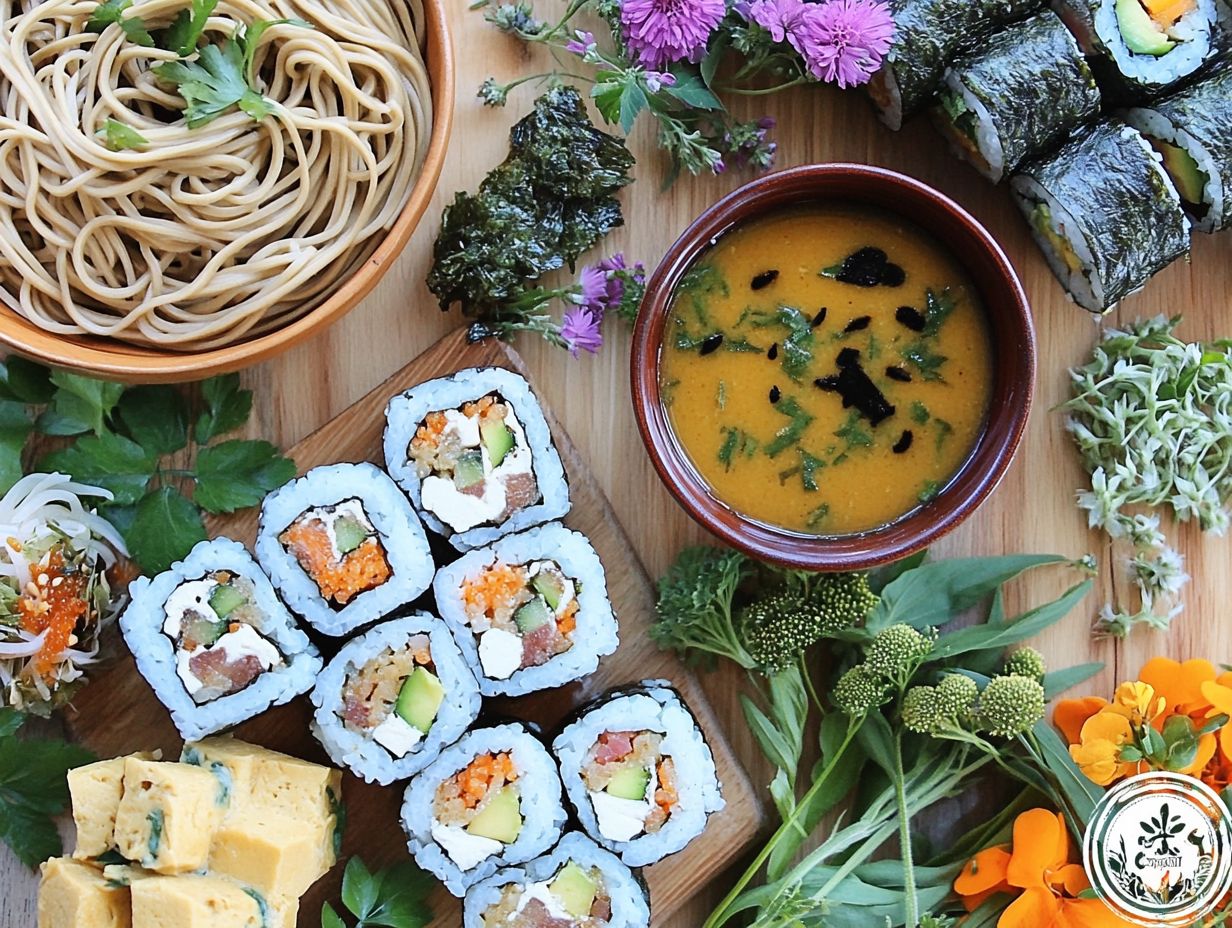 Classic Japanese breakfast recipes can be transformed into delicious vegan versions that retain their healthful properties, making them suitable for a plant-based diet. For instance, a clear, umami-rich miso soup can be enhanced with tofu and seasonal vegetables, while rice can be served as donburi with various savory toppings that elevate the umami experience. These adaptations ensure that even traditional favorites remain satisfying and nourishing for everyone. To recreate the rich umami flavors characteristic of Japanese cuisine, ingredients such as shiitake mushrooms, seaweed, and fermented soy products can be utilized. A chickpea-based pancake can serve as a substitute for the traditional okonomiyaki, offering a unique texture and additional nutritional benefits. This approach not only enhances meals but also introduces a broader audience to umami-rich vegan dishes, demonstrating that plant-based eating can be just as comforting and familiar as non-vegan options without sacrificing flavor.
Classic Japanese breakfast recipes can be transformed into delicious vegan versions that retain their healthful properties, making them suitable for a plant-based diet. For instance, a clear, umami-rich miso soup can be enhanced with tofu and seasonal vegetables, while rice can be served as donburi with various savory toppings that elevate the umami experience. These adaptations ensure that even traditional favorites remain satisfying and nourishing for everyone. To recreate the rich umami flavors characteristic of Japanese cuisine, ingredients such as shiitake mushrooms, seaweed, and fermented soy products can be utilized. A chickpea-based pancake can serve as a substitute for the traditional okonomiyaki, offering a unique texture and additional nutritional benefits. This approach not only enhances meals but also introduces a broader audience to umami-rich vegan dishes, demonstrating that plant-based eating can be just as comforting and familiar as non-vegan options without sacrificing flavor.
Lunch Recipes
Lunch is an excellent opportunity to savor filling and healthy vegan Japanese recipes. Creative bento boxes, filled with savory ingredients like tofu, fresh vegetables, and edamame, offer a delightful meal that is perfect for eating on the go. Additionally, comforting noodle dishes such as vegan ramen or stir-fried noodles provide a satisfying way to enjoy authentic Japanese flavors while adhering to a healthy diet.
Quick and Easy Bento Box Ideas
Creating a vegan bento box is simple and enjoyable. The bento box is a Japanese meal concept that typically combines rice, noodles, fish, and vegetables in a single serving. You can apply the same principles to make a vegan version, using a mix of rice, tofu, a variety of colorful vegetables, and snacks like seaweed or edamame. This approach makes for a fun and healthy lunch that encourages variety, allowing you to incorporate multiple flavors, nutrients, and plant-based protein from the diverse ingredients. The main challenge often lies in knowing which flavors complement each other to create a complete and tasty bento box. To start, use a base of whole grains such as quinoa or brown rice, which should comprise about 30% of your meal. These grains are excellent sources of carbohydrates, protein, and fiber, aligning with a healthy lifestyle. Next, include protein-rich plant options such as marinated tempeh, chickpeas, black beans, or roasted eggplant. Aim for about 40% of the bento box to consist of fresh vegetables. Colorful choices like bell peppers, carrots, and snap peas not only enhance the visual appeal but also add a delightful crunch and texture. For extra flavor, consider incorporating one or two spoonfuls of pickled vegetables or a drizzle of tamari. Adding dressings or sauces at the end can elevate the taste. Finally, reserve the remaining 10-20% of the bento box for nutritious, crunchy snacks to complete the meal. Seaweed snacks or edamame are great options that contribute to the overall umami experience. Choose snacks based on your caloric needs and personal preferences to make your vegan bento box truly satisfying.
Noodle and Rice Dishes
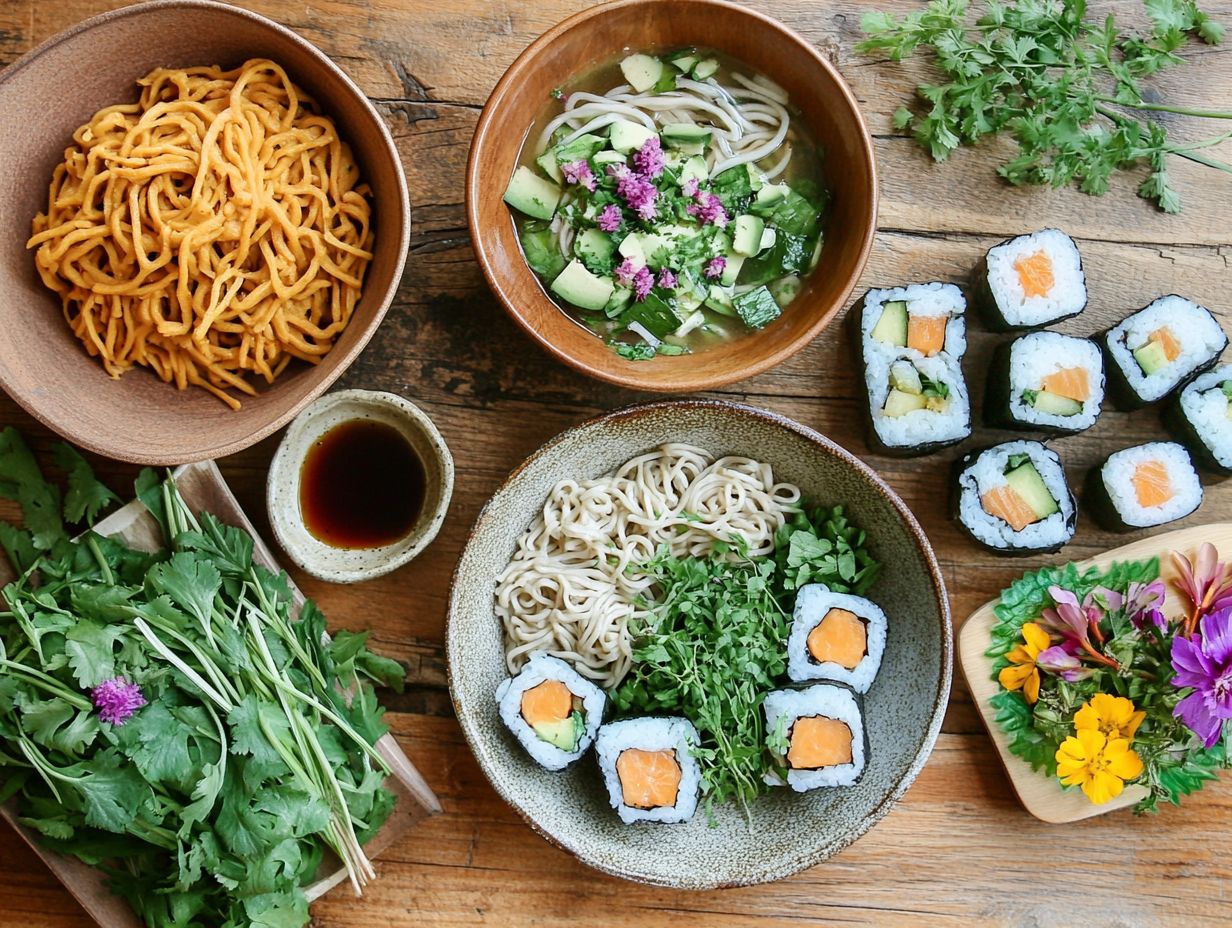 Vegan noodle dishes and rice recipes are among the most wholesome lunch options, offering hearty and satisfying meals that showcase the essence of Japanese cooking. Popular choices include:
Vegan noodle dishes and rice recipes are among the most wholesome lunch options, offering hearty and satisfying meals that showcase the essence of Japanese cooking. Popular choices include:
- Ramen with a rich vegetable broth and toppings like tofu and fresh vegetables
- Udon noodles stir-fried with seasonal produce
- Comforting bowls of soba noodles dressed with miso
These simple yet flavorful dishes are an integral part of Japanese meal traditions and can be easily enjoyed as plant-based meals. Each dish provides a wonderful opportunity to savor the flavors of Japan while enhancing your cooking skills by experimenting with various broths and aromatic seasonings. Ingredients such as miso paste, different oils, and a splash of soy or teriyaki sauce can elevate the flavor profile of these dishes, appealing to a wide range of palates. Incorporating protein-rich ingredients like edamame or tempeh is a healthy way to enhance both the nutrition and texture of these meals. Additionally, replacing traditional noodles with zucchini or sweet potato noodles allows for the creation of delicious gluten-free versions without sacrificing authentic flavors.
Dinner Recipes
Dinner is the perfect opportunity to enjoy a variety of flavorful vegan Japanese recipes that are filling and suitable for any occasion. Some delightful dinner options include:
- Savory tofu curry served over rice
- Crispy vegetable-filled gyoza
- Other comforting plant-based dishes
Traditional teriyaki recipes, which typically feature chicken, beef, or fish, can easily be adapted to include plant-based proteins. These satisfying meals contribute to a healthy intake of calories and nutrients, making them ideal for dinnertime.
Plant-Based Versions of Popular Japanese Dinner Dishes
Creating plant-based versions of popular Japanese dinner dishes offers the opportunity to blend traditional culinary experiences with vegan principles. For instance, katsu curry can be prepared with crispy tofu or jackfruit, while teriyaki sauce can enhance an array of saut ed vegetables. Gyoza can replace meat with a mixture of fragrant herbs and plant-based ingredients, providing comforting and flavorful alternatives. Ramen is another beloved Japanese dish that can easily embrace a vegan twist by using vegetable broth, shiitake mushrooms, an assortment of seasonal greens, and tofu for a rich umami flavor. Sushi rolls can be filled with avocado, cucumber, and marinated pickled vegetables, creating a vibrant burst of flavor that will appeal to both vegans and non-vegans alike. Additionally, tempura can be adapted by using seasonal vegetables coated in a light batter for a crispy, guilt-free crunch. These adaptations not only celebrate the essence of Japanese cuisine but also invite everyone to explore the remarkable diversity and depth of plant-based cooking, demonstrating that veganism can offer comfort and authentic taste without compromising on flavor.
One-Pot Meals for Busy Weeknights
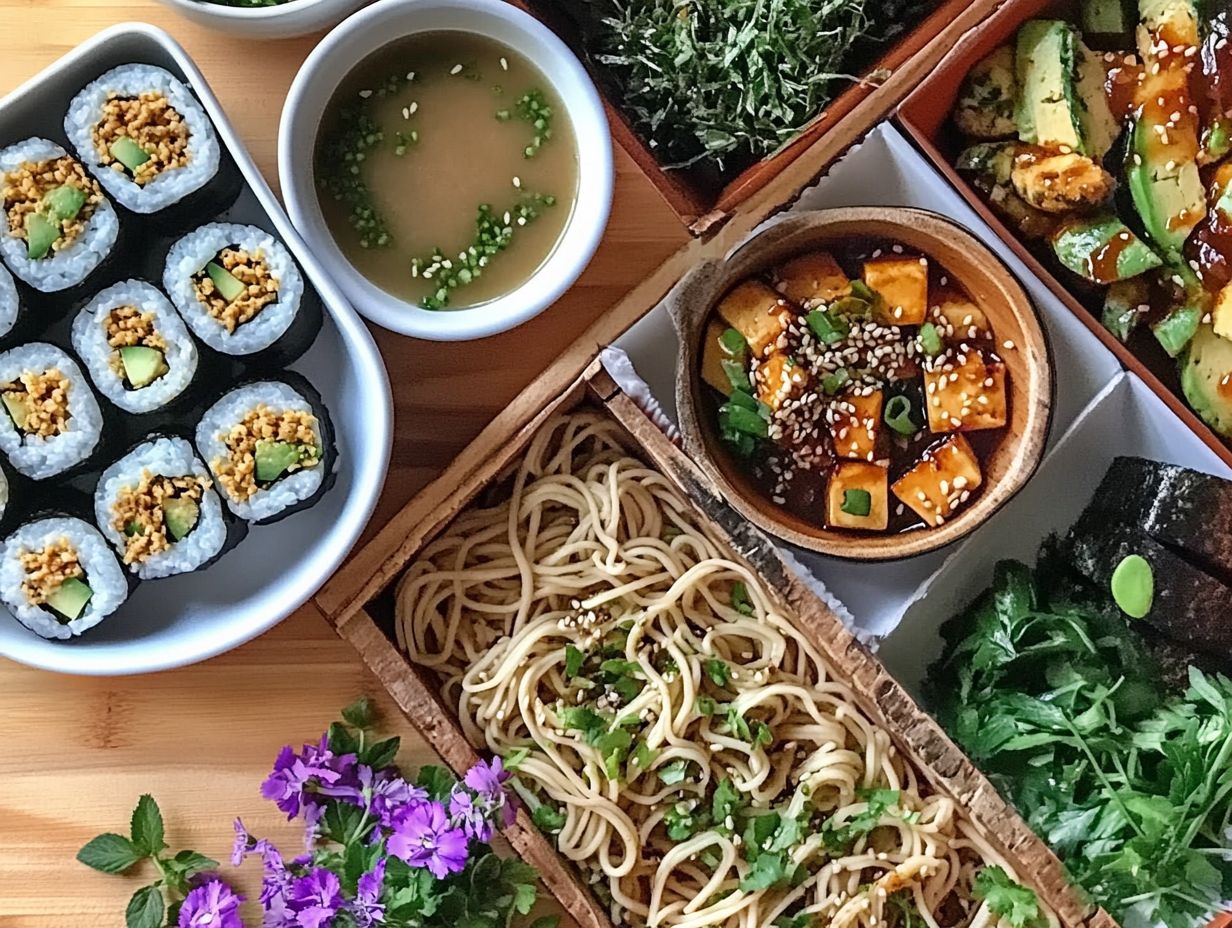 One-pot meals provide a quick and easy way to prepare delicious vegan Japanese recipes. These meals combine noodles, vegetables, and a savory broth, and can be made in under an hour, making them perfect for healthy dinners on busy weeknights. The right combination of flavors and textures, including spicy notes and savory broths, in these one-pot Japanese dishes can satisfy cravings while keeping meal preparation to a minimum. Additionally, they significantly reduce the time and effort required for cleanup, allowing you to focus on enjoying your meal rather than worrying about tidying up the kitchen. Here are some delightful one-pot Japanese vegan recipes you can try, perfect for a comforting meal:
One-pot meals provide a quick and easy way to prepare delicious vegan Japanese recipes. These meals combine noodles, vegetables, and a savory broth, and can be made in under an hour, making them perfect for healthy dinners on busy weeknights. The right combination of flavors and textures, including spicy notes and savory broths, in these one-pot Japanese dishes can satisfy cravings while keeping meal preparation to a minimum. Additionally, they significantly reduce the time and effort required for cleanup, allowing you to focus on enjoying your meal rather than worrying about tidying up the kitchen. Here are some delightful one-pot Japanese vegan recipes you can try, perfect for a comforting meal:
- Miso ramen with colorful vegetables
- Soba noodles with mixed vegetables
- Vegan udon noodle soup
- Vegan Japanese curry with vegetables
- Vegan soba noodles stir-fry with tofu and vegetables
- Vegan sukiyaki with tofu and vegetables
- Vegan shabu shabu with tofu and vegetables
Dessert Recipes
Vegan desserts inspired by Japanese cuisine offer a delightful option for those seeking to satisfy a sweet craving while maintaining a healthy diet, adhering to a plant-based lifestyle. Traditional mochi filled with fruits and the distinct flavors of matcha exemplify healthy, plant-based recipes that add a creative twist to classic tastes. Additionally, other delectable desserts incorporate natural sweeteners and wholesome ingredients, resulting in indulgent treats that honor the artistry of Japanese cuisine.
Sweet Treats with a Japanese Twist
Vegan desserts inspired by Japanese cuisine can introduce new flavors and health benefits to traditional sweets. For instance, vegan mochi, made from glutinous rice flour, can be filled with fresh fruits or sweetened bean paste, offering a chewy texture and delightful sweetness. Desserts like matcha brownies or cakes expand the flavor profiles while remaining plant-based and nutritious. Exploring innovative vegan desserts inspired by traditional Japanese sweets unveils a treasure trove of diverse flavors and textures. For example, black sesame can be blended into creamy puddings to impart a nutty richness that pairs beautifully with coconut milk, all while being dairy-free and healthy, ideal for any dinner party. The preparation techniques often focus on steaming and gentle flavors, highlighting a balance of sweetness with umami notes from ingredients such as miso or soy sauce, reminiscent of traditional Japanese culinary techniques. Incorporating seasonal fruits can elevate these recipes, resulting in stunning presentations that tantalize both the taste buds and the eyes, transforming each dessert into a sensory celebration, much like a sushi roll does in a savory dish.
Healthy and Indulgent Options
Achieving a balance between health and indulgence in vegan desserts is possible through holistic recipes that enhance the natural flavors of the ingredients while still providing a satisfying sense of indulgence, akin to the enjoyment of a well-crafted vegan sushi. Options like fruit-based parfaits, chia seed puddings, and other healthy desserts flavored with matcha or sweetened with natural sweeteners make excellent choices for dessert after any meal, especially those featuring dishes like a teriyaki bowl or a sushi platter. These healthy desserts, made from wholesome ingredients, allow for guilt-free indulgence and align with the core philosophy of Japanese gastronomy, promoting a healthy lifestyle through their authentic taste. Vegan desserts can benefit greatly from exploring the delicate interplay of sweet and savory flavors, as well as utilizing seasonal fruits. Ingredients such as adzuki beans or coconut milk can contribute texture and depth while honoring traditional tastes. By carefully balancing the role of each ingredient, it is possible to create vegan desserts that are not only flavorful but also visually appealing. This attention to detail enhances the overall enjoyment of the dish, ensuring that even those who may be less enthusiastic about the absence of sugar, dairy, or gluten can appreciate the harmonious flavor balance.

